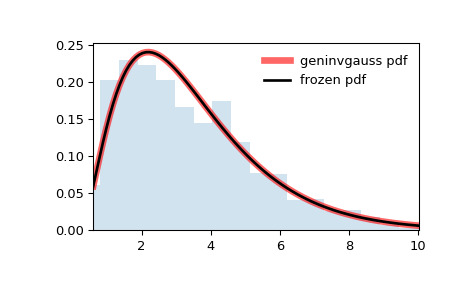本文简要介绍 python 语言中 scipy.stats.geninvgauss 的用法。
用法:
scipy.stats.geninvgauss = <scipy.stats._continuous_distns.geninvgauss_gen object>#广义逆高斯连续随机变量。
作为
rv_continuous类的实例,geninvgauss对象从它继承了一组通用方法(完整列表见下文),并用特定于此特定发行版的详细信息来完成它们。注意:
geninvgauss的概率密度函数为:其中x > 0,p是一个实数并且b > 0([1])。是二阶修正贝塞尔函数p(scipy.special.kv)。
上面的概率密度在“standardized” 表格中定义。要移动和/或缩放分布,请使用
loc和scale参数。具体来说,geninvgauss.pdf(x, p, b, loc, scale)等同于geninvgauss.pdf(y, p, b) / scale和y = (x - loc) / scale。请注意,移动分布的位置不会使其成为“noncentral” 分布;某些分布的非中心概括可在单独的类中获得。逆高斯分布stats.invgauss(mu)是一个特例
geninvgauss和p = -1/2,b = 1 /mu和规模 = 亩.对于这种分布,生成随机变量具有挑战性。该实现基于[2]。
参考:
[1]O.Barndorff-Nielsen、P. Blaesild、C. Halgreen,“广义逆高斯分布的首次命中时间模型”,随机过程及其应用,第 7 期,第 49-54 页,1978 年。
[2]W. Hoermann 和 J. Leydold,“生成广义逆高斯随机变量”,统计与计算,24(4),p。 547-557,2014 年。
例子:
>>> import numpy as np >>> from scipy.stats import geninvgauss >>> import matplotlib.pyplot as plt >>> fig, ax = plt.subplots(1, 1)计算前四个时刻:
>>> p, b = 2.3, 1.5 >>> mean, var, skew, kurt = geninvgauss.stats(p, b, moments='mvsk')显示概率密度函数(
pdf):>>> x = np.linspace(geninvgauss.ppf(0.01, p, b), ... geninvgauss.ppf(0.99, p, b), 100) >>> ax.plot(x, geninvgauss.pdf(x, p, b), ... 'r-', lw=5, alpha=0.6, label='geninvgauss pdf')或者,可以调用分布对象(作为函数)来固定形状、位置和比例参数。这将返回一个 “frozen” RV 对象,其中包含固定的给定参数。
冻结分布并显示冻结的
pdf:>>> rv = geninvgauss(p, b) >>> ax.plot(x, rv.pdf(x), 'k-', lw=2, label='frozen pdf')检查
cdf和ppf的准确性:>>> vals = geninvgauss.ppf([0.001, 0.5, 0.999], p, b) >>> np.allclose([0.001, 0.5, 0.999], geninvgauss.cdf(vals, p, b)) True生成随机数:
>>> r = geninvgauss.rvs(p, b, size=1000)并比较直方图:
>>> ax.hist(r, density=True, bins='auto', histtype='stepfilled', alpha=0.2) >>> ax.set_xlim([x[0], x[-1]]) >>> ax.legend(loc='best', frameon=False) >>> plt.show()
相关用法
- Python SciPy stats.genpareto用法及代码示例
- Python SciPy stats.genlogistic用法及代码示例
- Python SciPy stats.gennorm用法及代码示例
- Python SciPy stats.genhalflogistic用法及代码示例
- Python SciPy stats.genexpon用法及代码示例
- Python SciPy stats.genhyperbolic用法及代码示例
- Python SciPy stats.gengamma用法及代码示例
- Python SciPy stats.genextreme用法及代码示例
- Python SciPy stats.geom用法及代码示例
- Python SciPy stats.gumbel_l用法及代码示例
- Python SciPy stats.gzscore用法及代码示例
- Python SciPy stats.gompertz用法及代码示例
- Python SciPy stats.gibrat用法及代码示例
- Python SciPy stats.gmean用法及代码示例
- Python SciPy stats.gamma用法及代码示例
- Python scipy.stats.gilbrat用法及代码示例
- Python SciPy stats.gstd用法及代码示例
- Python SciPy stats.gaussian_kde用法及代码示例
- Python SciPy stats.gumbel_r用法及代码示例
- Python SciPy stats.gausshyper用法及代码示例
- Python SciPy stats.goodness_of_fit用法及代码示例
- Python SciPy stats.anderson用法及代码示例
- Python SciPy stats.iqr用法及代码示例
- Python SciPy stats.skewnorm用法及代码示例
- Python SciPy stats.cosine用法及代码示例
注:本文由纯净天空筛选整理自scipy.org大神的英文原创作品 scipy.stats.geninvgauss。非经特殊声明,原始代码版权归原作者所有,本译文未经允许或授权,请勿转载或复制。
